Clint Hill (Secret Service)
Clinton J. Hill (born January 4, 1932) is a former United States Secret Service agent who served under five United States presidents, from Dwight D. Eisenhower to Gerald Ford. Hill is best known for his act of bravery while in the presidential motorcade on November 22, 1963 when United States President John F. Kennedy was assassinated in Dallas, Texas.[1]
Clint Hill | |
|---|---|
 Hill at the 2016 Texas Book Festival | |
| Born | Clinton J. Hill January 4, 1932 |
| Occupation | Agent |
| Children | 2 |
During the assassination, Hill ran from the car immediately behind the presidential limousine, leaped onto the back of it and shielded Jacqueline Kennedy Onassis and the stricken president with his body as the car raced to Parkland Memorial Hospital. This action was documented in the Zapruder film. Since the death of Nellie Connally in September 2006, Hill is the last surviving person who was in the presidential limousine that day.
Early life
Hill was born in Larimore, North Dakota, to a Norwegian mother, Alma Pettersen. His birth parents homesteaded near Roseglen. At three months of age, he was placed in an orphanage in Fargo, where he was adopted by another Norwegian family, Chris and Jennie Hill of Fargo. Originally named Haugen, the family later changed its name to the English version of the name; Haugen means "the hill" in Norwegian.[2][3] Hill's new family took him to Washburn, where he eventually graduated from Washburn High School.[3] He attended Concordia College in Moorhead, Minnesota,[3] where he played football, basketball, and baseball, studied history, and graduated in 1954. After college, Hill joined the army and became a Counterintelligence (CI) Special Agent, serving until 1957. After his military service, Hill joined the Secret Service and was assigned to the Denver office. In 1958, Hill served on the detail for President Dwight D. Eisenhower.[4] After John F. Kennedy was elected president of the United States, Hill was assigned to protect the First Lady, Jacqueline Kennedy.
Assassination of President Kennedy
President Kennedy was assassinated on November 22, 1963 in Dallas, Texas, during a motorcade through the city, en route to a luncheon at the Dallas Trade Mart. The president and Mrs. Kennedy were riding in an open limousine containing three rows of seats. The Kennedys were in the rear seat of the car, the governor of Texas, John Connally, and his wife, Nellie Connally, were in the middle row, Secret Service agent William Greer was driving and the president's bodyguard, Roy Kellerman, was also in the front row.

Hill was riding on the left front running board of the Secret Service car immediately behind the presidential limousine. After the second shot, Hill began running to overtake the moving car in front of him, but the third shot had hit Kennedy in the head by the time that he arrived at the limousine. He climbed from the rear bumper, crawling over the trunk to the back seat where the president and First Lady were located. In the moments immediately after the fatal shots, Mrs. Kennedy climbed out of the back seat toward the trunk. Hill pushed her back into the car and covered her and the fatally wounded president with his body.
Hill, along with Secret Service agents Kellerman, Greer, and Rufus Youngblood, provided testimony to the Warren Commission in Washington, D.C. on March 9, 1964.[5]
Hill grabbed a small handrail on the left rear of the trunk, normally used by bodyguards to stabilize themselves while standing on small platforms on the rear bumper. According to the Warren Commission's findings, there were no bodyguards stationed on the bumper that day because:
...the President had frequently stated that he did not want agents to ride on these steps during a motorcade except when necessary. He had repeated this wish only a few days before, during his visit to Tampa, Florida.[6]
The notion that the president's instructions in Tampa jeopardized his security in Dallas has since been denied by Hill and other agents. Regardless of the Warren Commission's findings, photos taken of the motorcade along earlier segments of the route show Hill riding on the step at the back of the car.
As an alternative explanation, fellow agent Gerald Blaine cites the location of the shooting:
We were going into a freeway, and that's where you take the speeds up to 60 and 70 miles an hour. So we would not have had any agents there anyway.[7]
Hill grabbed the handrail less than two seconds after the fatal shot to the President. The driver then accelerated, causing the car to slip away from Hill, who was in the midst of trying to leap onto it. He succeeded in regaining his footing and jumped onto the back of the quickly accelerating vehicle.

As he got on, Mrs. Kennedy, apparently in shock, was crawling onto the flat rear trunk of the moving limousine. Hill later told the Warren Commission that he thought Mrs. Kennedy was reaching for a piece of the president's skull that had been blown off. He crawled to her and guided her back into her seat. Once back in the car, Hill placed his body above the president and Mrs. Kennedy. Meanwhile, in the folding jump seats directly in front of them, Mrs. Connally had pulled her wounded husband, Governor John Connally, to a prone position on her lap.
Agent Kellerman, in the front seat of the car, gave orders over the car's two-way radio to the lead vehicle in the procession "to the nearest hospital, quick!" Hill was shouting as loudly as he could: "To the hospital, to the hospital!" En route to the hospital, Hill flashed a "thumbs-down" signal and shook his head from side to side at the agents in the follow-up car, signaling the graveness of the president's condition.
The limousine then rapidly exited Dealey Plaza and sped to Parkland Memorial Hospital, only minutes away, followed by other vehicles in the motorcade. Hill maintained his position shielding the couple with his body, and was looking down at the president. He later testified:
The right rear portion of his head was missing. It was lying in the rear seat of the car. His brain was exposed. There was blood and bits of brain all over the entire rear portion of the car. Mrs. Kennedy was completely covered with blood. There was so much blood you could not tell if there had been any other wound or not, except for the one large gaping wound in the right rear portion of the head.[5]
As the hospital staff attended to Kennedy and Connally, Hill received a telephone call from Attorney General Robert Kennedy, the president's brother. Hill declined to tell Kennedy over the phone that his brother was dead, saying in a 2013 interview: "I explained to him that both the president and the governor had been shot and that we were in the emergency room at Parkland Hospital. So then he said, ‘Well, how bad is it?’ Well, I didn't want to tell him his brother was dead. I didn't think it was my place. So I said, ‘It's as bad as it can get.’”[8]
Although the Secret Service was shocked at its failure to protect the life of President Kennedy, virtually everyone agreed that Clint Hill's rapid and brave actions had been without blemish. He was honored at a ceremony in Washington just days after the funeral of John F. Kennedy. Mrs. Kennedy, despite being in deep mourning, made an appearance at the event to thank him in person.
After the assassination
Hill remained assigned to Mrs. Kennedy and the children until after the 1964 presidential election. He then was assigned to President Lyndon B. Johnson at the White House. In 1967, when Johnson was still in office, Hill became the Special Agent in Charge (SAIC) of presidential protection. When Richard Nixon came into office, Hill moved over to SAIC of protection of Vice President Spiro Agnew. Finally, Hill was assigned to headquarters as the assistant director of the Secret Service for all protection. He retired in 1975.[9]
In a 1975 interview with Mike Wallace, Hill tearfully surmised that if he had reached the vehicle a second earlier, he would have been able to take the third shot to his own body, and felt a great deal of regret for not having been able to reach there in time.[9]
Hill wrote the foreword to Gerald Blaine and Lisa McCubbin's 2010 narrative, The Kennedy Detail.[10]

In a BBC Today interview, broadcast in December 2010, Hill recalled the assassination and his first visit to Dallas in 1990 since the events of 1963, during which he surveyed the scene of the shooting. Asked whether he thought that the President's life might have been saved if things had been done differently, Hill replied that "He [Lee Harvey Oswald] had all the advantages that day. We had none. And it was a very easy job to accomplish because of the way everything was laid out."[11]
Hill was interviewed by Brian Lamb on C-SPAN's talk show Q&A in May 2012.[12]
In April 2012, the book Mrs. Kennedy and Me was published, in which Hill looked back at his career and described his working relationship with Jacqueline Kennedy.[13] The same year, Hill was inducted into the Scandinavian-American Hall of Fame, a signature event of the North Dakota-based organization Norsk Høstfest.[14]
In 2012, Hill was reported to have lived in Alexandria, Virginia, for "many years."[3][12]
In November 2013, to coincide with the 50th anniversary of the assassination, Hill's book Five Days in November was published, giving his view of the events.[15]
In 2016, Hill released Five Presidents: My Extraordinary Journey with Eisenhower, Kennedy, Johnson, Nixon, and Ford, which summarized his entire Secret Service career.[16]
On October 5, 2018, Hill received the Theodore Roosevelt Rough Rider Award from Doug Burgum, the Governor of North Dakota. The award is North Dakota's award for residents and former residents of North Dakota.[17]
Personal life
Hill was married to his wife Gwen at the time of Kennedy's assassination. The couple had two sons.[12] In his 2012 interview with Brian Lamb, Hill suggested that he had been divorced or separated from her for many years.[12] As of 2013, Hill lived near San Francisco.[18]
In popular culture
- In the two-part Quantum Leap episode "Lee Harvey Oswald," Dr. Sam Beckett "leaps" out of Oswald and into Clint Hill, immediately before the moment of the famous photo is taken of Hill leaping onto the back of the Kennedy limousine. Sam feels great guilt that this did not prevent Kennedy's assassination. However, as Beckett's friend Al points out, in the "original" history, Oswald had also killed Jackie Kennedy, and Sam's true mission all along was to save her life.
- In the alternative history novel Surrounded by Enemies: What If Kennedy Survived Dallas? by Bryce Zabel, Hill was killed in the process of saving Kennedy from being shot. In this story he is the second person killed protecting a president. (Leslie Coffelt, a White House policeman, was killed in the line of duty in 1950 protecting President Harry Truman from an assassination attempt.)
- Hill appears as a character in the 2016 film Jackie, portrayed by David Caves.
References
- Hill, Clint (2017). "Clint Hill". Retrieved June 12, 2017.
- – Hun var i sjokk og sa «Jeg har hjernen hans i hendene» - TV 2 Nyhetene
- Ogden, Eloise (September 25, 2012). "A witness to history: Former Secret Service agent talks about N.D. & Jacqueline Kennedy". Minot Daily News. Minot, North Dakota. Retrieved September 26, 2012.
- ‘Mrs. Kennedy’: A relationship of respect, protection, love. USA Today, April 2, 2012. Retrieved April 19, 2013.
- "Testimony Of Clinton J. Hill, Special Agent, Secret Service". Hearings Before the President's Commission on the Assassination of President John F. Kennedy, Volume II. Washington, D.C.: United States Government Printing Office. 1964. pp. 61, 132–144.
- Report of the President's Commission on the Assassination of President Kennedy. p. 45.
- CNN: "JFK Secret Service agents reflect on loss of a President", CNN.com (Nov. 22, 2010)
- Pelley, Scott (November 22, 2013). "Jackie wouldn't let go of JFK, first agent to reach president says". CBS News. Retrieved October 7, 2016.
- King, Larry (March 22, 2006). "Larry King Interviews Mike Wallace". CNN.
- Dobbin, Muriel (November 19, 2010). "BOOK REVIEW: 'The Kennedy Detail'". The Washington Times. Washington, D.C. Retrieved May 26, 2013.
- "JFK assassination 'was easily done'". BBC. December 1, 2010. Retrieved January 7, 2012.
- Q & A - Clint Hill. C-SPAN, May 27, 2012. Retrieved November 28, 2014.
- "Book review: 'Mrs. Kennedy and Me'". The Washington Times. April 6, 2012. Retrieved April 7, 2012.
- "SAHF Inductees". hostfest.com. Norsk Høstfest.
- "Clint Hill on 'Five Days in November'". The Washington Post. November 25, 2013. Retrieved November 25, 2014.
- "Adventures of a Secret Service agent who served five presidents". The Washington Post. May 5, 2016. Retrieved May 8, 2016.
- 'Former Secret Service Agent Clint Hill to receive Rough Rider Award,' Bismarck News, Keith Darney, October 5, 2018
- Walters, Joanna (November 20, 2013). "Secret Service agent still wonders if one second would have saved JFK". Al Jazeera America. New York City. Retrieved December 22, 2014.
External links
- Appearances on C-SPAN
- Q&A interview with Clint Hill and Gerald Blaine, C-SPAN, November 28, 2010.
- Television interview with Clint Hill, from The Today Show, April 5, 2012.
- Clint Hill interviewed by Mike Wallace in 1975, from 60 Minutes Rewind, January 11, 2011.
Bibliography
- Hill, Clint; McCubbin, Lisa (2012). Mrs. Kennedy and Me. S&S/Gallery. ISBN 978-1-4516-4844-7.
- Hill, Clint; McCubbin, Lisa (2013). Five Days in November. S&S/Gallery.
- Hill, Clint; McCubbin, Lisa (2016). Five Presidents: My Extraordinary Journey with Eisenhower, Kennedy, Johnson, Nixon, and Ford. S&S/Gallery. ISBN 978-1476794136.